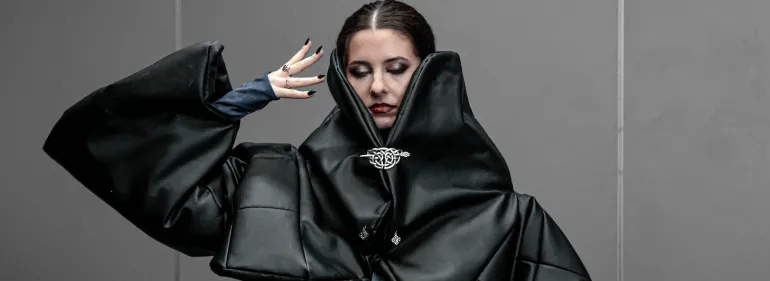BA (Hons) in Fashion Design

Course Overview
Cultivate your creativity, innovate, and develop your original ideas with this practical design course.
Explore your personal design direction with our BA (Hons) in Fashion Design and gain an incredible opportunity to succeed in the fashion industry. Check out Griffith Creative 2024 to view our final year student's work and see what you could create as part of Griffith College Design or click the image below.
Why Study Fashion Design at Griffith College?
Our BA (Hons) in Fashion Design is a three-year Level 8 degree available full-time, immersing you in all aspects of the fashion industry and preparing you for roles that require both creative flair and technical and business knowledge.
- Through our Fashion Design and Garment Construction modules, students develop practical skills and cultivate a personal design philosophy.
- Our syllabus includes training in the latest 3D CAD pattern and manufacturing (CAM) technology, complemented by business and professional practice knowledge.
- Students create a fashion collection, exploring their personal design direction from idea generation and design development to pattern creation and garment construction using contemporary production techniques.
- Our programme reflects changes in the fashion industry, acknowledging the shift of traditional manufacturing bases to low-cost economies. Students learn to think creatively, adapt to industry changes, and develop the skills necessary to liaise with offshore production facilities.
- Develop professional practice skills through modules in branding, marketing, business, and entrepreneurship.
- 100% continuous assessment means learners do not need to sit written exams.
- The calibre of our fashion graduate's work has been recognised through numerous industry awards and exhibitions.
- Graduates are prepared for roles as fashion designers, buyers, trend forecasters, visual merchandisers, and other positions requiring creative design, technical, and business knowledge. Our graduates' collections can be found at Brown Thomas Create, Havana Boutique, Marion Cuddy, Om Diva, and the Design House.
- Full access to the Student Adobe Creative Cloud - All apps plan, offering over 20 cutting-edge creative tools for desktop, mobile, and web.
Course Highlights
- Design an innovative fashion collection
- Hone digital fashion design and visual communication skills
- Build expertise in branding, marketing, and entrepreneurship
- Learn in a dynamic environment led by expert lecturers
- Engage in live industry projects
- Showcase your work in a Fashion Graduate Exhibition with opportunities for Industry Internship Awards
Experienced Lecturers
Throughout the course, you will learn from a diverse faculty of practicing designers, garment technologists, buyers, art historians, photographers, journalists, business experts, and craft practitioners. This ensures that the programme maintains strong, up-to-date industry connections.
Fashion Internships and Careers
Year after year, Griffith College has awarded internships to students and graduates in fashion companies both in Ireland and abroad.
Graduates of our Fashion Design Courses in Dublin have gone on to work at Avoca, Caroline Kilkenny, CVUK London, Ella Boo, Ellis Bridal, Emmett Equestrian, Esquire Footwear, Filmbase, Gareth Pugh, GW Global Trading, Heatons, Helen Mcalinden, Home Studios London, Hybrid Fashion, Joanne Hynes Design, Kathy De Stafford, Louboutin, Louis Copeland, Louis Vuitton, Mariana Jungmann, Mirjam Rouden, Native Clothing Designs, Nicole Farhi, Percival, Primark Stores, Reiss, Rick Owens, Simone Rocha, Soho Apparel, Styletex and Vivienne Westwood.
Questions? Have a look at our FAQ section.
Intake Dates
- Dublin - Full-Time - September 2025
Are you applying through the CAO?
Check out our CAO HUB for more information about applying through the CAO!
Course Codes
- Dublin: GC494
What our students say

I really enjoy our pattern making class with Nicola, and I loved working with Anne-Marie, especially when she helped us turn our patterns into garments and achieve the best outcomes possible. Another class I enjoyed is our 3D class. It’s such a cool, new way to approach fashion.
Fashion Design

My favourite memory from Griffith is definitely the fashion design process. I love seeing how little sketches at the very start can evolve into something like your own collection. I also loved the people I met and the teachers.
Fashion Design
Course Details
The BA (Hons) in Fashion Design provides students with a comprehensive and rigorous foundation for careers in the fashion industry. The programme emphasises project-based learning, encouraging students to experiment and innovate to develop imaginative design solutions. Industry-based assignments ensure that graduates are well-equipped for employment, whether within a company or as independent designers.
Students are immersed in all facets of the fashion industry, from traditional tailoring, draping, and embellishment techniques to fashion illustration and computer-aided design (CAD) skills. The fashion design and technology modules foster the exploration of a personal design style, guiding students through the entire process from idea generation and design development to pattern creation and garment construction using contemporary production techniques.
Graduates of the program are successfully working as fashion designers, liaising with offshore production facilities, buyers, trend forecasters, and visual merchandisers.
Year One
In this core design module, learners develop drawing skills and appropriate design research methods to develop original concepts to inspire personal creative ideas to drive collections. Project briefs introduce various stages of design, including research, concept, design development, selection, and presentation skills. As learners start to understand the process necessary to create an original design, they gain confidence in their design, selection, and presentation skills. Selected designs are realised in Garment Construction 1.
In this module, learners acquire skills to translate their designs from a specification sheet to a final complete garment using industry-standard pattern drafting and basic garment production techniques.
The module advances learners' skills in three design communication tools and printing. The learning outcomes of this module underpin a lot of the learning to be applied in other modules and so contribute to most of the intended programme learning outcomes.
This module gives the learner a broad understanding of how the fashion industry operates by looking at the sectors in the fashion industry, from couture to mass production, the schedule, processes, and roles involved. Learners gain an understanding of the social and environmental impact of the fashion industry, the problems and challenges. The module highlights how ethical and circular design is now a driving force for most brands.
This module traces the evolution of historical fashion in the social, economic, and political contexts from the mid-nineteenth century up to the present time. It focuses on the most important couturiers that were active from c. 1850, describing how their key innovations were made and worn and their contribution to the history of haute couture. The module introduces academic referencing, essay research, structure, and writing skills, enabling learners to establish their own voice in an academic environment.
In this core fashion design module, learners work through project briefs that embed much of the design theory and drawing skills explored in semester 1 and understand the process necessary to create original design. Learners gain confidence in design development through drape and presentation skill-builds. Learners acquire creative awareness, select designs, and define design detail to translate to specification sheets for realisation in Garment Construction 2.
In this module, learners achieve competency and confidence to create creative patterns and assemble garments using appropriate industry sewing techniques and materials. Learners acquire skills to create garments using production techniques, demonstrating readiness to progress to tailoring.
This module teaches the learner a variety of advanced bitmap and vector graphics editing skills and how to apply practical desktop publishing solutions. It also teaches the learner to creatively apply and communicate effectively graphic techniques employing the use of a grid and typography, apply the technical skills for print production, and format a design and layout project or digital drawing for print.
This module provides the learner with a broad understanding of the theory and application of textiles to garment design. Both practice and theory are explored so learners advance their ability to identify fibres and fabrics and understand the importance of the application of appropriate materials to design
The module gives learners a broad understanding of historical, cultural, social, and political contexts in which modern and postmodern design evolved. The learning outcomes of this module underpin some of the learning to be applied in other modules (Visual Culture and Theory; Design Futures; Dissertation) and so contribute to some of the intended programme learning outcomes.
Year Two
In this core fashion design module, learners gain specialist knowledge of sectors within the fashion industry and design two collections. Learner’s practice advanced and creative 2D and 3D design development draping on the stand to achieve a higher level of creativity and fluent silhouette development. Projects involve authentic learning to equip learners with knowledge of fashion industry sectors to facilitate future employment opportunities. Learners translate detailed design to specification with appropriate material considerations and identify production techniques for realisation in Garment Construction 3 and 4.
In this module, learners build on the basic pattern drafting skills introduced in the first year and acquire more advanced technical tailoring pattern drafting and sewing skills required to support Fashion Design 3 and 4 projects. The curriculum is also structured to advance exploration of creative drapes and sustainable design solutions. Draping on the stand builds confidence and fluency of design, moving toward experimentation with more advanced pattern drafting.
Fashion illustration enables the learner to further develop their freehand fashion drawing skills and gain digital fashion drawing skills, learning to effectively communicate design and meaning. Learners produce a digital vector library of technical flat garment drawings, symbols, and brushes for design details; developing a portfolio of both freehand and digital fashion figure poses and art forum fashion illustrations.
The Design Futures module provides learners with a broad understanding of theoretical contexts of major movements in art, design, and visual culture—both historical and contemporary. This module provides crucial context for creative activity, working in tandem with practical modules by exposing learners to major concepts, structures, thinkers and practitioners
This module addresses key factors to be considered when starting a small business: entrepreneurial theories, business concepts through planning a feasibility project, a lean start-up style canvas, and customer analysis.
This core fashion design module builds a high level of creative awareness, design fluency, and industry processes and broadens the learner’s design experience and skill set by introducing areas of specialist knowledge with workshops that involve trend research, planning and forecasting, knit and print design, and fashion illustration. These areas require industry-specific research, advanced design, new illustration techniques, and visual presentation skills appropriate to the trend forecasting sector expectations. Learners must achieve fluent design competencies and a portfolio demonstrating visual literacy, industry expertise, and readiness to progress to the final stage of the level 8 programme.
In this module, learners create their Mini Collection, as designed in Fashion Design 3, and explore advanced creative pattern drafting techniques required to create their designs. Sewing workshop demonstration: using industry equipment, learners develop a range of advanced sewing and finishing skills with confidence. Learners are prepared to progress to employment or to the final stage of the level 8 programme when advanced pattern drafting and garment construction are required to execute a degree collection meeting industry standards.
This module enables the learner to develop skills in the use of the digital camera for photography and video and explore industry standards in this area. It introduces the basic principles of photography and video, with the emphasis being on images within their design studio practice.
This module covers the nature and role of marketing in a design business. They learn to identify the environmental variables, segmentation, targeting and positioning, marketing mix for a creative brand, and create a marketing plan.
In support of Fashion Design 4, the learner creates digital textile design, repeats textile pattern for print, colourways, and applies fabric rendering techniques, digitally drawn fashion figure illustration, and technical flats with rendering. This Digital Fashion Portfolio module enables the learner to further develop effective visual communication skills, working across digital platforms to create a digital online and printed portfolio to showcase their Mini Collections for the end-of year showcase.
Year Three
This is the core capstone module running over 2 semesters. The main project brief requires learners to design and make a Major Collection, while other projects completed include briefs for: Design for Diversity, an Industry Design, and a Professional Practice and Portfolio that reflect career aspirations and can be used to present at an interview for future work. Topics covered are portfolio layout, video, CVs and interview techniques, collection branding and marketing material, photoshoot direction and styling, graduate showcase presentations, press packs, and oral presentation techniques. The Major Collection is a 12-outfit graduate collection (4 of which are made in the Garment Construction Projects and 3D Digital Design modules). These demonstrate the learner’s proficiency in design, innovation, and professional practice and that they can maintain a sustained involvement in the proficient management and resolution of their work. The work culminates in the end-of year showcase.
In completing this module, new approaches to pattern cutting are presented, and projects include a pre-collection Design for Diversity brief to design for alternative body shapes/genders/ages/needs selecting customers from the college campus. The module’s group project advances the understanding of grading and experimental pattern-cutting techniques to develop fit, proportions, and design to meet the needs of customer diversity. This project is followed with tech packs and costings workshops to advance learners' understanding in the key areas of fashion clothing production and to support advanced specification and costings. Creative pattern workshops inspire learners to explore design ideas preparing for collection development in support of their Major Fashion Project, which enables learners to create a personal collection.
This core module is the culmination of the learner’s study. Through research and writing of their dissertation, learners will explore subjects deemed worthy of academic investigation, or the expansion and development of new ideas through practice. On completion of the module, the learner may select to present an academic dissertation or a dissertation by practice.
This module introduces the tools and techniques of the latest 3D Digital Design software, the fashion design software program, to create virtual 3D true-to-life garment visualisation with simulation technology for the clothing manufacturing industry. This module provides the opportunity for learners to experience industry practice, to virtually fit and adjust patterns, and to create a 3D representation of design with realistic texture and animation to realise design.
Design is a complex creative field, encompassing a range of ways of working and patterns of professional engagement. This module prepares learners for entry to the workplace or higher study through experience of professional portfolio development and related promotional activities. It helps learners to assess not only their position within the design industry but also to define their individual creative strengths and present work to a high professional standard.
Timetables
Monday to Friday from 10 AM - 5 PM.
*Timetables are subject to change. For the most up-to-date information, please contact the Faculty directly.
How to Apply
Entry Requirements
All applicants for this course must submit a general art and design portfolio.
Portfolio Requirements
All applicants to this programme are required to submit a general art and design portfolio, demonstrating creativity and observational drawing skills through the development of creative project work. Our portfolio guidelines are available here.
Please upload your portfolio using this platform: here
All candidates are required to upload a digital portfolio. Before you begin, you will need either a CAO Application Number or a Griffith College application number so please make sure you have made an application to the CAO or to Griffith College (as appropriate) for one of our Honours degree programmes.
Deadline: Candidates must select an assessment date when uploading their portfolio. You must upload your portfolio by your chosen date.
- Friday, 31st January 2025
- Friday, 28th February 2025
- Friday, 28th March 2025
- Friday, 25th April 2025
- Friday, 30th May 2025
- Friday, 27th June 2025
If you have a query or you require further information about submitting a portfolio, please contact admissions@griffith.ie.
Advanced Entry
Level 5 holders:
Candidates with a Level 5 qualification who obtain 3 distinctions and 5 passes (plus a portfolio) may be eligible for entry into year 1 of this course. Candidates under 23 years of age still need to apply through the CAO. Mature students can apply directly here.
Level 6 holders:
Applicants with a Level 6 qualification in a related discipline may be eligible for advanced entry into this course. Candidates will be asked to provide relevant transcripts and a portfolio of work in support of their application. Pending the strength of the portfolio, candidates may be eligible for entry into year 1 or year 2 of this programme.
All candidates with a Level 6 qualification, regardless of age, will need to apply directly here.
*Please note, advanced entry applications are assessed on a case by case basis and offers are made at the discretion of the faculty.
English Language
Applicants from countries where English is not the first language will also be required to provide evidence of sufficient English language abilities.
Griffith College is accepting the online Duolingo English Test (DET) as valid proof of English proficiency. For more information, please visit here.
How to apply:
CAO Applicants / Applicants under 23 years of age:
Applicants under 23 years old on the 1st of January the year the course begins must submit a copy of their Leaving Cert results. Candidates must have obtained a minimum of two subjects at grade H5 and four at grade O6/H7. These results must include a language (English or Irish) and either Maths or Art.
Candidates with equivalent grades from FETAC colleges and those holding awards, including BTEC qualifications, will also be considered.
Applicants under 23 years of age on 1st January the year the course begins must apply through the CAO system. Please consult the CAO website for details on key dates for applications.
CAO course code: GC494
Applicants over 23 years of age (Mature students):
Applicants who are 23 years of age on or before the 1st of January the year the course begins are considered mature learners and therefore do not apply via the CAO. They will be asked to submit a copy of their ID (passport or driving license) only.
Applicants who are 23 years of age on or before the 1st of January the year the course begins, may apply as a mature student. Mature students must apply to Griffith College directly online using the Apply Online facility.
Fees
For purposes of fee calculation, residence is counted from the time of application.
Please note that not all study modes may be offered at all times. For confirmation, refer to the intake dates in the Overview tab.
Tuition Fees
Study Mode: Full-Time
Dublin: EUR 6,850.00
Study Mode: Full-Time
Please refer to the Irish/EU Living Abroad Fees section.
Study Mode: Full-Time
Dublin
Non-EU living in Ireland or abroad: Please refer to our Non-EU Tuition Fees section.
Non-EU students: a Student Services and Administration fee of EUR200 is payable each academic year in addition to the fees quoted below.
An Academic Administration Fee of EUR300.00 and a 2% Protection of Enrolled Learners Fee is applicable each academic year in addition to the fees quoted:
Flexible payment options
Students wishing to pay their fees monthly may avail of our direct debit scheme. Please view our Fees information page for more information and assistance.
Sponsorship
Is your company paying for your course?
They will need to complete a Griffith College Sponsorship Form and send this to the Student Fees Office:
- Post: Student Fees, Griffith College Dublin, South Circular Road, Dublin 8
- Email: accounts@griffith.ie
2% Learner Protection Charge
All QQI accredited programmes of education and training of 3 months or longer duration are covered by arrangements under section 65 (4) of the Qualifications and Quality Assurance (Education and Training) Act 2012 whereby, in the event of the provider ceasing to provide the programme for any reason, enrolled learners may transfer to a similar programme at another provider, or, in the event that this is not practicable, the fees most recently paid will be refunded.
QQI Award Fee
Please note that a QQI Award Fee applies in the final year of all QQI courses. To find the relevant fee for your course level, please see the Fees page.
Progression
Career Progression
Through the BA (Hons) in Fashion Design, you will have gained valuable design experience, built a strong foundation of creativity, and covered a diverse range of topics. There is a wide range of career options for our graduates including:
- Fashion Designer
- Fashion Illustrator
- Costume Designer
- Fashion Forecaster
- Fashion Stylist
- Fashion Buyer
- Fashion Journalist
- Offshore Manager
- Pattern Drafter
- Production Supervisor
- Quality Controller
- Fabric and Trims Purchaser
- Fashion Show Producer
- Garment Technologist
- Image Consultant


